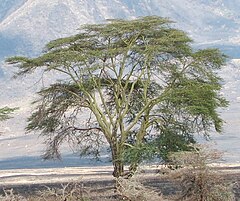| Habit | tree
| |
|---|---|---|
| Height: | ⇕ | 50 ft"ft" can not be assigned to a declared number type with value 50. |
| Width: | ⇔ | 20 ft"ft" can not be assigned to a declared number type with value 20. to 40 ft"ft" can not be assigned to a declared number type with value 40. |
| Lifespan: | ⌛ | perennial |
| Bloom: | ❀ | early spring, mid spring, late spring |
| Exposure: | ☼ | sun |
|---|---|---|
| Features: | ✓ | deciduous, flowers, fragrance |
| USDA Zones: | 9 to 11 | |
| Flower features: | ❀ | orange, yellow |
|
Fabaceae > |
Acacia > |
Acacia xanthophloea is a tree in the Fabaceae family and is commonly known as the Fever Tree. This species of Acacia is native to South-eastern Africa. It can be found in Botswana, Kenya, Malawi, Mozambique, Somalia, South Africa, Swaziland, Tanzania, Zambia and Zimbabwe.[1] It has also become a landscape tree in other warm climates, outside of its natural range.
The trees grow to a height of around 15–25 m. The characteristic bark is smooth and greenish-yellow in colour, and it is notable for being one of the few trees where a relatively large amount of photosynthesis takes place in the bark. Straight, white thorns grow from the branches in pairs. The leaves are twice compound, with small leaflets (8 x 2 mm). The flowers are scented golden-yellow balls, clustered at the nodes and towards the ends of the branches. These trees produce fruits in the form of pods. These trees also grow "sacrificial limbs" which appear as dead branches where unwanted nutrients from the soil are dumped.[2]
Cultivation
Propagation
Pests and diseases
Varieties
Gallery
References
External links
- w:Acacia xanthophloea. Some of the material on this page may be from Wikipedia, under the Creative Commons license.
- Acacia xanthophloea QR Code (Size 50, 100, 200, 500)
